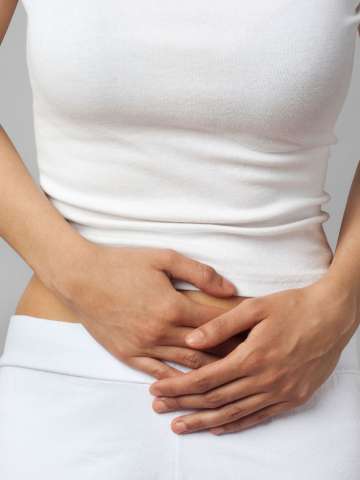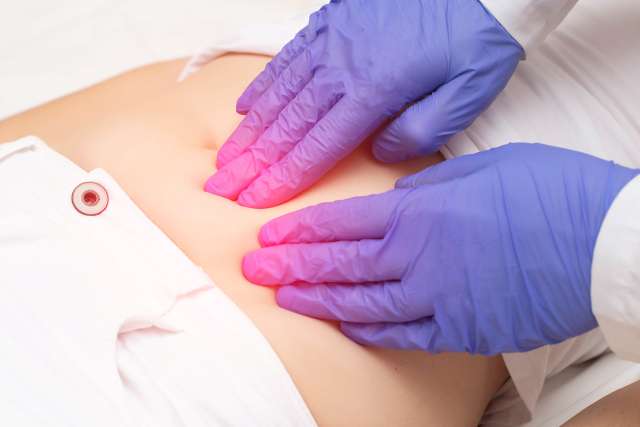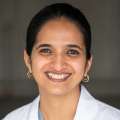Fibroid Care
We treat women with uterine fibroids using minimally invasive and noninvasive procedures whenever possible. Our team-based approach provides timely and effective relief.

Why choose UCLA Health for fibroid care?
At the UCLA Health Uterine Fibroid Program, our experts treat all types of fibroids in the uterus. Uterine fibroids are common, noncancerous growths in the uterus that are usually not serious. When fibroid symptoms include complications and pain, we provide you with leading treatments and compassionate care.
Highlights of our program include:
Comprehensive diagnostics: We offer a full array of diagnostic and therapeutic procedures for uterine fibroids. You receive a thorough evaluation from an experienced team.
Tailored treatment plans: We customize your care plan based on your symptoms. Our goal is to deliver the safest, most effective treatments, so you can stay healthy.
Team-based approach: Our fibroid specialists include gynecologists, urogynecologists, diagnostic radiologists, interventional radiologists and nurse practitioners. This multispecialty team works collaboratively to streamline your care, so you receive coordinated, comprehensive treatment.
Minimally invasive and noninvasive procedures: We offer treatments that result in fewer incisions and help you recover faster. Our approach eases fibroid symptoms without affecting surrounding healthy tissue.
Types of fibroids we treat
The three main types of fibroids we treat are:
- Intramural: This type grows within the muscle wall of the uterus.
- Submucosal: These fibroids may grow into the open space inside the uterus.
- Subserosal: These grow outside the uterus.
Fibroid symptoms
Fibroids usually develop during childbearing years. Most women who develop fibroids experience no symptoms. When fibroids become large or multiply, they may cause:
- Bleeding between periods
- Difficulty getting pregnant
- Frequent urination
- Heavy or prolonged periods
- Low back pain
- Pain during intercourse
- Pelvic pain and pressure
How we diagnose fibroids
Doctors typically diagnose fibroids in the uterus during a physical checkup or imaging test. Your doctor may feel a firm, irregular lump during a pelvic exam. Some fibroids may be detected with:
Ultrasound: This test uses sound waves to provide detailed images of your uterus and fibroids.
MRI: This scan uses powerful magnets and radio waves to create detailed images showing the size, number and location of fibroids.
Saline infusion sonography: This form of ultrasound provides images of the inside of the uterus. Saline infusion sonography helps doctors determine the cause of unusual vaginal bleeding.
In some cases, your doctor may perform additional tests. These may include:
Hysterosalpingogram (HSG): After inserting a catheter (small tube) in the uterus, your doctor injects a dye and takes X-rays. Doctors often use this test for women having trouble getting pregnant.
Hysteroscopy: Your doctor inserts a long, thin camera and light (hysteroscope) through the vagina and cervix into the uterus. This method may be used to diagnose the cause of infertility or miscarriages.
Laparoscopy: Your doctor makes a tiny incision near your naval. The doctor then inserts a long, thin camera and light (laparoscope) in the abdomen and pelvis. This method often helps to identify the source of pelvic or abdominal pain.
Fibroid treatments we offer
We offer the full spectrum of minimally invasive and noninvasive fibroid procedures. Our expert teams use the least invasive treatment possible to relieve your symptoms and eliminate your pain. Options include:
Nonsurgical treatments
Our fibroid experts work closely with you to customize your treatment plan. Nonsurgical options include:
Watchful waiting: Fibroids are common and rarely cancerous. Most women have mild or no symptoms. Your doctor may recommend monitoring fibroids over time.
Alternative therapy: You may experience symptom relief with healthy lifestyle choices and bodywork therapies. Our nutrition and lifestyle coaches can help you manage stress and improve sleep and nutrition. We can also help you find a provider at the UCLA Center for East-West Medicine to meet your specific needs.
Medications: Doctors often prescribe medications to manage fibroid pain, pressure and bleeding. Examples include hormone therapy and drugs that treat cramping and pain, such as gonadotropin-releasing hormone agonists, hormonal contraceptives or nonsteroidal anti-inflammatory drugs.
Uterine artery embolization (UAE): This option, also known as uterine fibroid embolization (UFE), involves a minimally invasive procedure to decrease bleeding, pressure and pain. Doctors insert a small tube (catheter) through an artery in the groin or wrist and guide it to the arteries supplying the fibroids with blood. The catheter releases small particles that cut off blood supply to the fibroids so they shrink. Up to 90% of women experience significant pain relief after UAE.
Radiofrequency ablation, or Sonata ® treatment: Doctors insert an ultrasound device through the vagina into the uterus to target fibroids with radiofrequency energy. Sonata treatment reduces the size of fibroids, easing symptoms.
Surgical treatments
If nonsurgical treatments fail to resolve your symptoms, doctors may recommend surgery. We offer two surgical options:
Myomectomy: We remove only the fibroids and preserve the uterus. Doctors may use a nonsurgical or minimally invasive procedure, or they may perform traditional open surgery with a large incision in the abdomen. In some patients, myomectomy can be performed hysteroscopically (by inserting a thin, flexible tube with a small camera into the uterus)
Hysterectomy: Surgeons remove the uterus, which contains the fibroids. Hysterectomy may be performed as a minimally invasive procedure or traditional open surgery. UCLA is one of the few sites offering vNOTES (transvaginal natural orifice transluminal endoscopic surgery). This technique does not require an incision, so recovery time is shorter.
Meet our team
The UCLA Health expert team includes gynecologists, urogynecologists, diagnostic radiologists, interventional radiologists and nurse practitioners. Together, they work to evaluate your concerns and offer a tailored treatment plan. Our clinical team promotes patient education and emphasizes collaborative care, so you get the information and attention you deserve.
Leadership Team
Obstetrics and Gynecology Fibroids Specialists
Interventional Radiology Fibroid Specialists
Nurse Practitioner Fibroid Specialists
Obstetricians-Gynecologists
Contact us
OB/GYN appointments
If you’re looking to review fibroid treatment options for fibroids in the uterus with an OB/GYN provider or want a second opinion, please call 310-794-7274.
Radiology appointments
If you already have a provider helping you manage a fibroid condition and are interested in uterine artery embolization (UAE) treatment, please call 310-481-7545.
Find your care
You receive exceptional care and personalized pain management from an expert team. Call to connect with our fibroid experts.
OB/GYN appointments
If you’re looking to review fibroid treatment options with an OB/GYN provider or want a second opinion, please call: 310-794-7274
Radiology appointments
If you already have a provider helping you manage a fibroid condition and are interested in uterine artery embolization (UAE) treatment, please call 310-481-7545.































